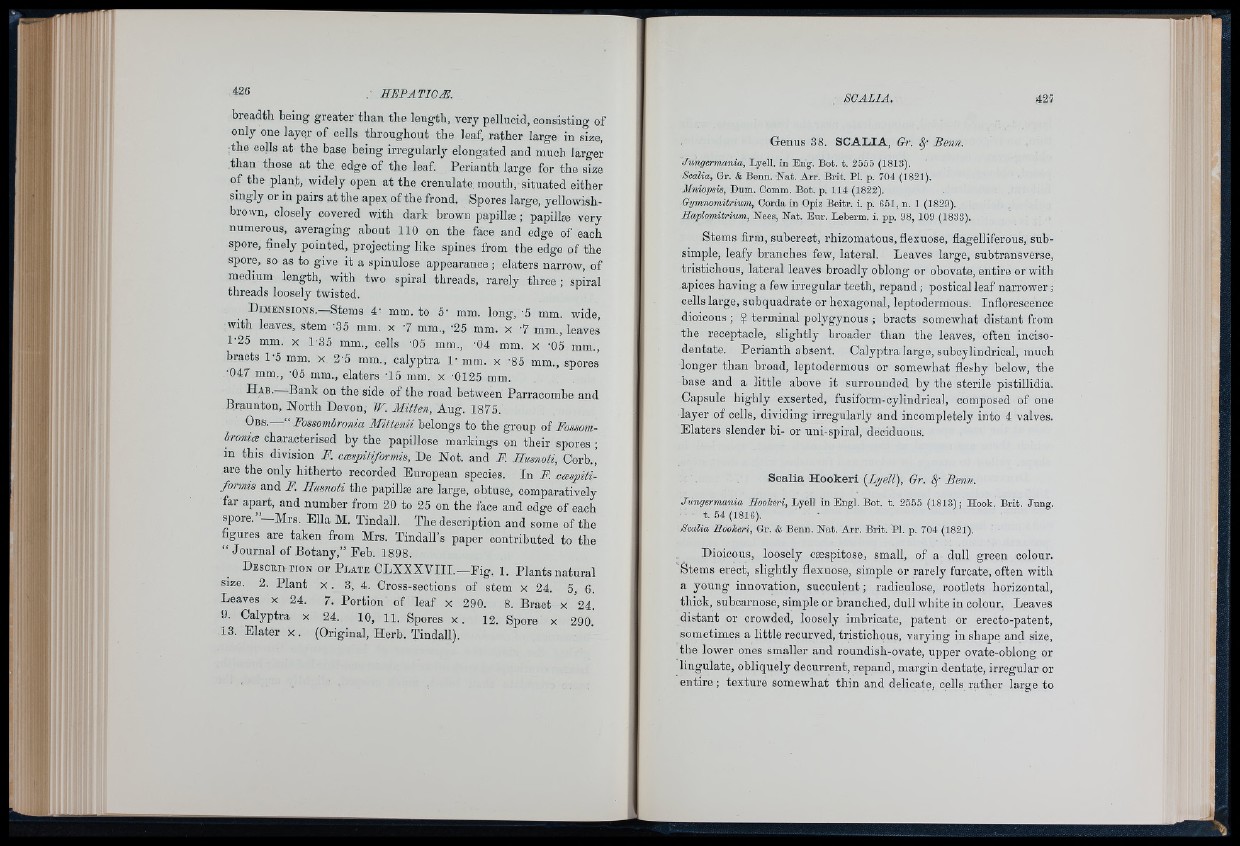
breadth being greater than the length, very pellucid, consisting of
only one layer of cells throughout the leaf, rather large in size,
■the cells at the base being irregularly elongated and much larger
than those at the edge of the leaf. Perianth large for the size
of the plant, widely open at the crenulate mouth, situated either
singly or in pairs at the apex of the frond. Spores large, yellowish-
brown, closely covered with dark brown papillæ; papillæ very
numerous, averaging about 110 on the face and edge of each
spore, finely pointed, projecting like spines from the edge of the
spore, so as to give it a spinulose appearance ; elaters narrow, of
medium length, with two spiral threads, rarely three ; spiral
threads loosely twisted.
D imensions.—Stems 4- mm. to 5 ' mm. long, '5 mm. wide,
with leaves, stem '35 mm. x 7 mm., ‘25 mm. x 7 mm., leaves’
1-25 mm. x 1-35 mm., cells '05 mm., -04 mm. x '05 mm.,
braots lA mm. x 2A mm., calyptra F mm. x '85 mm., spores’
•047 mm., -05 rnm., elaters -15 mm. x •0125 mm.
H a b . Bank on the side of the road between Parracombe and
Braunton, North Devon, W. Mitten, Aug. 1875.
Obs.—“ Fossomhronia Mittenii belongs to the group of Fossombronia
characterised by the papillose markings on their spores ;
m this division F. cæspitiformis, De Not. and F. Husnoti, Corb.,
are the only hitherto recorded European species. In F. .cæspitiformis
and F. Husnoti the papillæ are large, obtuse, comparatively
far apart, and number from 20 to 25 on the face and edge of each
spore. Mrs. Ella M. Tindall. The description and some of the
figures are taken from Mrs. Tindall’s paper contributed to the
“ Journal of Botany,” Feb. 1898.
Descrii-iion of P late C LX X X V III.-P ig . 1. Plants natural
size. 2. Plant x . 3, 4. Cross-sections of stem x 24. 5, 6.
Leaves x 24. 7. Portion of leaf x 290. 8. Bract x 24
9. Calyptra x 24. 10, 11. Spores x . 12. Spore x 290.'
13. Elater x . (Original, Herb. Tindall).
Genus 38. SCALIA, Gr. fl Benn.
a, Lyell. in Eng. Bot. t. 25.55 (1818).
lia, Gr. & Benn. Nat, Arr. Brit, PI. p. 704 (1821).
sis, Dum. Comm. Bot. p. 114 (1822).
Gymnomitrium, Corda in Opiz Beitr. i. p. 651, n. 1 (1829).
Haplomitrium, Nees, Nat. E u r. Leberm. i. pp. 98, 109 (1883),
Stems firm, suberect, rhizomatous, flexuose, flagelliferous, sub-
simple, leafy branohes few, lateral. Leaves large, subtransvei-se,
tristichous, lateral leaves broadly oblong or obovate, entire or with
apices having a few irregular teeth, repand ; postical leaf narrower;
cells large, suhquadrate or hexagonal, leptodermous. Inflorescence
dioicous ; $ terminal polygynous ; bracts somewhat distant from
the receptacle, slightly broader than the leaves, often inciso-
dentate. Perianth absent. Calyptra large, subcylindrioal, much
longer than broad, leptodermous or somewhat fleshy below, the
base and a little above it surrounded by the sterile pistillidia.
Capsule highly exserted, fusiform-cylindrical, composed of one
layer of cells, dividing irregularly and incompletely into 4 valves.
Elaters slender bi- or uni-spiral, deciduous.
Scalia Hookeri (Lyell), Gr. fl Benn.
lia Hookeri, Lyell in Engl. Bot. t. 2555 (1813); Hook. Brit. Ju n g ,
t. 54 (1816).
Scalia Hookeri, Gr. <k Benn. N a t. A rr. Brit. PI. p. 704 (1821),
Dioicous, loosely cæspitose, small, of a dull green colour.
Stems erect, slightly flexuose, simple or rarely furcate, often with
a young innovation, succulent ; radiculose, rootlets horizontal,
thick, suhcarnose, simple or branched, dull white in colour. Leaves
distant or crowded, loosely imbrioate, patent or ereoto-patent,
sometimes a little recurved, tristichous, varying in shape and size,
tbe lower ones smaller and roundish-ovate, upper ovate-oblong or
lingulate, obliquely deourrent, repand, margin dentate, irregular or
entire ; texture somewhat thin and delicate, cells rather large to